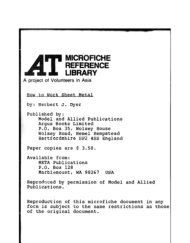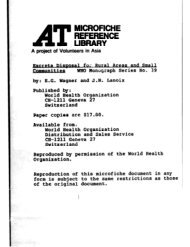You also want an ePaper? Increase the reach of your titles
YUMPU automatically turns print PDFs into web optimized ePapers that Google loves.
-.<br />
‘!. .? ’<br />
The fox or wild grape Witis j<br />
Idbrusca) is a fast-spreading vine .<br />
of waste places ,and countryside<br />
from New England to Georgia.<br />
Its berries yield a purple dye. _<br />
Many of them jth copper or iron sulfate gIany of the above plants are also<br />
produce greens of a variety of qualities. _ iltlportant for orange colors. Special. riote<br />
These greens with a~ilnlonin .eithrl: inten-. . is made in this respect to the entire group ’<br />
si$ or shift to tans &d browns. In the of Bidens, to the related genus Corqopsis, .!:‘:’<br />
case nf goldenrod the shift KIN hc tn D an*d tb Prunus. ‘Some of the colors are<br />
excellent blacks. intense ‘enough- t-0 vie with madder ’<br />
T’arious speci& ‘of Btrld~ir~tr, annuals (Rubia tiytoyum) for honors and many ,<br />
of the southern coastal’ plaid and the: Gulf er~n produce the gil~Ilf?t COlOrs associated<br />
. . States, occur in lillgrf? roloriies in the poor with madder.. Bedstraws (Galium), which<br />
*‘. soils of the pine barrens. They are excel- :lq! rlose.r+tives of madder,%rq’common ‘,<br />
, I lent Ilot only for yellows aud 1J~ilSS Gt,loYs<br />
but for icy cool greens if alum and<br />
but thti ‘roots are small and the” ability to<br />
produce’?he qa\!le colors as madder seems L<br />
copper sulfate are used. Inore n’rademic than useful. ’<br />
The grass genus Andropogo?z, in ,a11 its xX American r mistletoe (Phorudendron) , *<br />
many specirq’ranks among the best and is Inoidnlitcd w!th al;lm,” emerges ,from ,the ’ .<br />
one of the re;ognized yellows for bottom- dyebath pallid ‘ind ,pool:,until rinsed-with<br />
ing* with indigo for .greens. With alum alnlllonia wat’e;, when it chnlqes to briland<br />
copper it produces iti ‘own greeni& liant yellow: Jf stored overnight, wet, it<br />
without indigo orerdpeing. Audropogou often changes to a lovqly chartreuse.<br />
OCCURS throughout the East either in sin- The4 green ~+ulls of ‘black walnut and<br />
gle-stemmed plants or in larg? easily col- hutternilt trees a$: well known for their<br />
lected clumps, according to species. The intense brown$ Hickory hulls cati be use,d \ ”<br />
genus is found along rvadsides, in waste<br />
places and poor soils. Tt is superb for<br />
for. unusual ,gra.ys of remarkable clarity. ,_ ‘,<br />
Second-groith Anierican chestnits often : .<br />
1<br />
” drying for winter use.<br />
I<br />
j)rodurr burrs. that have high tinctorial<br />
power and &l’so”give a varkty of b?ci?Vqs _ . ”<br />
,;-I. depending ~lpon’the,moyd.ants used.<br />
*Bottoming involves dyeing a second c,plor Fetterbush or d&g hobble (Leu oboe<br />
over a first for a blend. It is a standard ,fo7rtcr)rkiann; fc+erly Lhcatesbgei 5 ‘, esmethod<br />
for ,obtaining greens. n peciaUy in late winter, g$es’unusual. ayd<br />
’<br />
20<br />
t,







